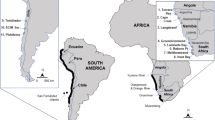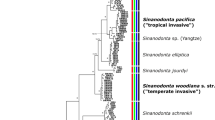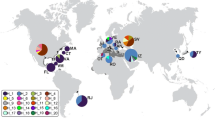Abstract
Biological and habitat characterization of the non-indigenous invasive species Xenostrobus securis was undertaken in the Ria de Vigo. This study included genetic identification of mussel samples collected from introduced and endemic areas, and the assessment of mussel size, population abundance, geographic distribution, pathological condition, and sediment composition of substrata type. The mussel had a marked patchy distribution, being more abundant in brackish sites with fine sediments and high organic matter content. Pathological analysis revealed that X. securis does not play any role as vector for introducing allochthonous pathogens in the Ria de Vigo. Nevertheless, depending on its invasiveness potential, the mussel could be a key host favouring spreading and epizootic outbreaks of marteliosis which is known to be harmful for local bivalve populations. Phylogenetic analyses of the COI gene placed all the resulting sequences in a clade within the genus Xenostrobus and its phylogeny congruent with an Australian/Pacific origin. The COI tree suggests two historical introductions in European waters. One of these invasions seems to have started in Galicia, moving from there towards Italy and France, while the geographical spread of the second invasion cannot be deciphered, although the Australian/Pacific origin of this invasion seems very possible. The 18S network is congruent with one invasion starting in Galicia or in Italy, as the Australian haplotype is closely related to the haplotype found in these areas. Several hypotheses accounting for the colonization history of this species in Galician waters are discussed.





Similar content being viewed by others
References
Akaike H (1974) A new look at the statistical model identification. IEEE Trans Automat Contr 19:716–723
Alonso A, Suárez P, Álvarez C, San Juan F, Molist P (2001) Structural study of a possible neoplasia detected in Mytilus galloprovincialis collected from the Ría of Vigo (NW Spain). Dis Aquat Organ 47:73–79
Álvarez-Iglesias P, Rubio B, Vilas F (1999) A case study of pollution by lead in intertidal sediments of San Simón Bay (Inner Ria de Vigo, NW Spain). Contribution to XUGA (PGIDT99MARAE1) and CICYT (MAR 97-0626) projects. www.scientificjournals.com/sj/espr_special/Pdf/aId/3657
Bañón R, Rolán E, García-Tasende M (2008) First record of the purple dye murex Bulinus brandaris (Gastropoda: Muricidae) and a revised list of non native molluscs from Galician waters (Spain, NE Atlantic). Aquat Invasions 3(3):331–334
Barber BJ (2004) Neoplastic diseases of commercially important marine bivalves. Aquat Living Resour 17:449–466
Carlton JT (1985) Transoceanic and interoceanic dispersal of coastal marine organisms: the biology of ballast waters. Oceanogr Mar Biol Annu Rev 23:313–371
Carrasco N, López-Flores I, Alcaraz M, Furones MD, Berthe FC, Arzul I (2007) Dynamics of the parasite Marteilia refringens (Paramyxea) in Mytilus galloprovincialis and zooplankton populations in Alfacs Bay (Catalonia, Spain). Parassitology 134(Pt 11):1541–1550
Clement M, Posada D, Crandall K (2000) TCS: a computer program to estimate gene genealogies. Mol Ecol 9(10):1657–1660
Crisp DJ (1974) Factors influencing the settlement of marine invertebrate larvae. In: Grant PT, Mackie AM (eds) Chemoreception in marine organisms. Academic Press, New York, pp 177–265
DAISIE (2009) Delivering alien invasive species inventories for Europe. http://www.europe-aliens.org/
Darrigran G (2002) Potential impact of filter-feeding invaders on temperate inland freshwater environments. Biol Invasions 4:145–156
Eckman JE (1983) Hydrodynamic processes affecting benthic recruitment. Limnol Oceanogr 28:241–257
Eckman JE, Werner FE, Gross TF (1994) Modelling some effects of behaviour on larval settlement in a turbulent boundary layer. Deep-Sea Res II 41:185–208
Folmer O, Black M, Hoeh W, Lutz R, Vrijenhoek R (1994) DNA primers for amplification of mitochondrial cytochrome c oxidase subunit I from diverse metazoan invertebrates. Mol Mar Biol Biotechnol 3(5):294–299
Fuentes JM, Villalba A, Zapata C, Álvarez G (1995) Effects of stock and culture environment on the infections by Marteilia refringens and Mytilicola intestinalis in the mussel Mytilus galloprovincialis cultured in Galicia (NW Spain). Dis Aquat Organ 21:221–226
Garci ME, Trigo JE, Pascual S, González AF, Rocha F, Guerra A (2007) Xenostrobus securis (Lamarck, 1819) (Mollusca: Bivalvia): first report of an introduced species in Galician waters. Aquac Int 15:19–24
Giusti F, Dell’Angelo B, Sosso M, Schiaparelli S (2008) First record of the invasive species Xenostrobus securis (Lamarck, 1819) (Bivalvia: Mytilidae) from Central Tyrrhenian Sea (Western Mediterranean). Boll Malacol 44:11–14
Gofas S, Zenetos A (2003) Exotic molluscs in the Mediterranean Basin: current status and perspectives. Ocean Mar Biol Annu Rev 41:237–277
Howard AW, Smith CS (1983) Histological techniques for marine bivalve molluscs. NOAA Technical Memorandum NMFS-F/NEC 25
Huelsenbeck JP, Ronquist F (2001) MRBAYES: Bayesian inference of phylogeny. Bioinformatics 17:754–755
Kimura T, Tabe M, Shikano Y (1999) Limnoperna fortunei kikuchii Habe 1981 (Bivalvia: Mytilidae) is a synonym of Xenostrobus securis (Lamarck, 1819): introduction into Japan from Australia and/or New Zealand. Venus 58:101–117
Kleeman SN, Adlard RD (2000) Molecular detection of Marteilia sydneyi, pathogen of Sydney rock oysters. Dis Aquat Organ 40(2):137–146
Kohama T, Montani S, Kajiwara Y, Yamada M (2001) Population dynamics of sessile bivalves Mytilus galloprovincialis and Xenostrobus securis in hyper eutrophicated bay, Japan. Bull Jpn Soc Fish Sci 67:664–671
Lazzari G, Rinaldi E (1994) Alcune considerazioni sulla presenza di specie extra Mediterranee nelle lagune salmastre di Ravenna. Boll Malacol 30:195–202
Le Roux F, Audemard C, Barnaud A, Berthe F (1999) DNA Probes as potential tools for the detection of Marteilia refringens. Mar Biotechnol 1(6):588–597
López-Flores I, de la Herrán R, Garrido-Ramos MA, Navas JI, Ruiz-Rejón C, Ruiz-Rejón M (2004) The molecular diagnosis of Marteilia refringens and differentiation between Marteilia strains infecting oysters and mussels based on the rDNA IGS sequence. Parasitol 129(Pt 4):411–419
López-Flores J, Robles F, Vlencia JM, Grau A, Villalba A, De la Herrán R, Garrido-Ramos MA, Ruiz-Rejón C, Ruiz-Rejón M, Navas JI (2008) Detection of Marteilia refringens using nested PCR and in situ hybridisation in Chamelea gallina from the Balearic Islands (Spain). Dis Aquat Organ 82:79–87
Mack RN, Simberloff D, Lonsdale WM, Evans H, Clout M, Bazzaz F (2000) Biotic invasions: causes, epidemiology, global consequences, and control. Ecol Appl 10(3):689–710
Medlin L, Elwood HL, Stickel S, Sogin ML (1988) The characterization of enzymatically amplified eukaryotic 16S-like rRNA-coding regions. Gene 71:491–499
Moore JD, Robbins TT, Hedrick RP, Friedman CS (2001) Transmission of the ricketsiales-like prokaryote “Candidatus Xenohaliotis californiensis” and its role in withering syndrome of California abalone, Haliotis spp. J Shellfish Res 20:867–874
Occhipinti-Ambrogi A (2000) Biotic invasions in a Mediterranean Lagoon. Biol Invasions 2:165–176
Pérez-Camacho A, Villalba A, Beiras R, Labarta U (1997) Absorption efficiency and condition of cultured mussels (Mytilus edulis galloprovincialis Linnaeus) of Galicia (NW Spain) infected by parasites Marteilia refringens Grizel et al. and Mytilicola intestinalis Steuer. J Shellfish Res 16:77–82
Posada D (2006) ModelTest Server: a web-based tool for the statistical selection of models of nucleotide substitution online. Nucleic Acids Res 34:W700–W703
Prego R, Cotté MH, Cobelo-García A, Martin JM (2006) Trace metals in the water column of the Vigo Ria: Offshore exchange in mid-winter conditions. Estuar Coast Shelf Sci 68:289–296
Prego R, Ferro P, Trujillo C (2008) Lead and Zinc contamination of surface sediments in the main harbours of the Galician Rias. J Iber Geol 34(2):243–252
Quilez-Badia G (2009) ICES WGITMO report: 91–115. Washington DC, USA
Rozen S, Skaletsky HJ (2000) Primer3 on the WWW for general users and for biologist programmers. In: Krawetz S, Misener S (eds) Bioinformatics methods and protocols: methods in molecular biology. Humana Press, Totowa, pp 365–386
Russo P (2001) Great concentration of Xenostrobus securis (Lamarck, 1819) in different areas of the Po River Delta. La Conchiglia 298:49–50
Sabelli B, Speranza S (1994) Rinvenimento di Xenostrobus sp. (Bivalvia: Mytilidae) nella laguna di Venezia. Boll Malacol 29(9–12):311–318
Santos-Echeandía J, Prego R, Cobelo-García A (2005) Copper, nickel, and vanadium in the Western Galician shelf in early spring after the prestige catastrophe: is there seawater contamination? Anal Bioanal Chem 382(2):360–365
Snelgrove PVR (1994) Hydrodynamic enhancement of invertebrate larval settlement in microdepositional environments: colonization tray experiments in a muddy habitat. J Exp Mar Biol Ecol 176:149–166
Snelgrove PVR, Butman CA, Grassle JP (1993) Hydrodynamic enhancement of larval settlement in the bivalve Mulinia lateralis (Say) and the polychaete Capitelia sp. I In the microdepositional environments. J Exp Mar Biol Ecol 168:71–109
Sousa R, Guilhermino L, Antunes C (2005) Molluscan fauna in the freshwater tidal area of the River Minho estuary, NW of Iberina Peninsula. Int J Limnol 41:141–147
Sousa R, Antunes C, Guilhermino L (2006) Factors influencing the occurrence and distribution of Corbicula fluminea (Müller, 1774) in the River Lima estuary. Int J Limnol 42:165–171
Sousa R, Gutierrez JL, Aldridge DC (2009) Non-indigenous invasive bivalves as ecosystem engineers. Biol Invasions. doi 10.1007/s10530-009-9422-7
Streftaris N, Zenetos A, Papathanassiou E (2005) Globalisation in marine ecosystems: the story of non-indigenous marine species across European seas. Oceanogr Mar Biol 43:419–453
Swofford DL (2000) PAUP*: phylogenetic analysis using parsimony (*and other methods), version 4. Sinauer Associates, Sunderland
Templeton AR, Crandall KA, Sing CF (1992) A cladistic analysis of phenotypic associations with haplotypes inferred from restriction endonuclease mapping and DNA sequence data. III. Cladogram estimation. Genetics 132:619–633
Turner EJ, Zimmer-Faust RK, Palmer MA, Lukenbach M, Pentcheff ND (1994) Settlement of oyster (Crassostrea virginica) larvae: effects of water flow and a water-soluble chemical clue. Limnol Oceanogr 39:1579–1593
Villalba A (2006) Different types of neoplasia in Crassostrea gigas, Venus verrucosa and Mytilus galloprovincialis from the Spanish coast. J Shellfish Res 25:786–787
Villalba A, Mourelle SG, Carballal MJ, López MC (1993a) Effects of infection by the protistan parasite Marteilia refringens on the reproduction of cultured mussels Mytilus galloprovincialis in Galicia (NW Spain). Dis Aquat Organ 17:205–213
Villalba A, Mourelle SG, López MC, Carballal MJ, Azevedo C (1993b) Marteiliasis affecting cultured mussels Mytilus galloprovincialis of Galicia (NW Spain). I. Etiology, phases of the infection, and temporal and spatial variability in prevalence. Dis Aquat Organ 16:61–72
Villalba A, Mourelle SG, Carballal SG, López C (1997) Symbionts and diseases of farmed mussels Mytilus galloprovincialis throughout the culture process in the Rías of Galicia (NW Spain). Dis Aquat Organ 31:127–139
Wallace IM, O’Sullivan O, Higgins DG, Notredame C (2006) M-Coffee: combining multiple sequence alignment methods with T-Coffee. Nucleic Acids Res 34(6):1692–1699
Wood AR, Smita A, MacAvoy ES, Gardner JPA (2007) A molecular phylogeny of the marine mussel genus Perna (Bivalvia: Mytilidae) based on nuclear (ITS1&2) and mitochondrial (COI) DNA sequences. Mol Phylogenet Evol 44:685–698
Zenetos A, Gofas S, Russo G, Templado J (2004) CIESM atlas of exotic species in the Mediterranean. In: Briand F (ed) Molluscs, vol. 3. CIESM Publishers, Monaco, 376 pp
Acknowledgments
Authors thank S. Gofas, J. Trigo, E. Rolán and E. Pulpeiro for their helpful comments on the first draft of the paper, and to JC Harshbarger for his helpful comments on gonadal neoplasia. Thanks are also due to Iain Suthers (University of New South Wales, Australia); Jacques Pelorce (Hydrologue membre de l’association du Grau-du-Roi, Camargue littoral environment, France) and G. Arcangeli (Istituto Zooprofilattico Sperimentale delle Venezie, Italy) for providing samples. J.A. Durán (IIM-CSIC), M. Meléndez, E. Penas and A. Ramilo (CIMA-Xunta de Galicia) assisted in technical analyses. Thank you to two anonymous reviewers for their excellent comments.
Author information
Authors and Affiliations
Corresponding author
Rights and permissions
About this article
Cite this article
Pascual, S., Villalba, A., Abollo, E. et al. The mussel Xenostrobus securis: a well-established alien invader in the Ria de Vigo (Spain, NE Atlantic). Biol Invasions 12, 2091–2103 (2010). https://doi.org/10.1007/s10530-009-9611-4
Received:
Accepted:
Published:
Issue Date:
DOI: https://doi.org/10.1007/s10530-009-9611-4




